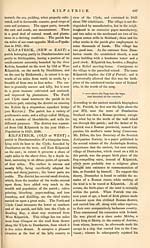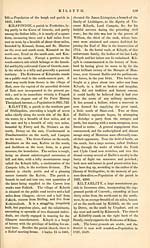Gazetteer of Scotland > Volume 2
(154) Page 638
Download files
Complete book:
Individual page:
Thumbnail gallery: Grid view | List view

638
KILKENNY.
parents in bis native country. Having now
acquired that gift of holiness for which he was
so distinguished, he re-visited Ireland in the
imposing character of an apostle of Christian-
ity ; and after a most eventful and useful life,
he died in 491, in the 120th year of his age.
There is good reason to suppose that he was
buried at Glasgow, on the spot which was
subsequently occupied by the cathedral. In
the river Clyde, opposite to the church, there
is, or was, a large stone or rock, visible at
low water, called St. Patrick's stone. As al-
ready mentioned, the celebrated wall of An-
toninus, which crossed the island from the
Forth to the Clyde, terminated on the west, in
this parish, at the place called Dunglas, and
vestiges of this massive work of art are still
visible. In much later times Dunglas was the
site of a fortlet which being situated on a low
rocky promontory on the Clyde, was service-
able in commanding the passage up or down the
river. It is now a complete ruin shrouded in
ivy, and has a romantic appearance in the eye
of the tourist. By a very excusable ignorance,
the writer of the Statistical Account, Webster,
and the common herd of topographers who
have blindly followed their descriptions, have
confounded this castle of Dunglas with another
of the same name, on the borders of East
Lothian and Berwickshire, (see Oldham-
stocks,) seven miles below Dunbar, by men-
tioning that it was blown up in the year 1 640,
by the treachery of an English boy, when the
Earl of Haddington and other persons of rank
were killed. The Dunglas on the Clyde,
which had no connexion with this event, was
formerly the property of the Colquhouns of
Luss, who likewise enjoyed the whole tract of
country from that to Dumbarton, at one time
known as the barony of Colquhoun. Adja-
cent to Dunglas on the west, rises a strangely
shaped basaltic hill, termed Dumbuck, which
shoots up its fantastic head into the air,
and bears a resemblance to the rock of Dum-
barton Castle in the vicinity. From the
propinquity and resemblance of these objects,
has arisen the proverbial expression in this
part of the country, that " after swallowing
Dumbuck, it's needless to make faces at Dum-
barton ;" a sentiment similar in moral signifi-
cation to the elegant adage, " Eat a cow and
worry at the tail." — Population of this parish
in 1821, 3692.
KILRENNY, a parish in the county of
P'ife, of a triangular form, with its base, of froru
two to three miles in extent, along the shore
of the Firth of Forth, near its mouth, and
having a depth inland of nearly the same di-
mensions. It includes the fishing village of
Cellardykes or Nether Kilrenny, on the coast
contiguous to Easter Anstrutber. The parish
of Crail encompasses the district on the north
and east. The shore is bold and rocky, and
is in some places perforated with caves. The
country is here under the best processes of pro-
ductive agriculture, and is well enclosed and
embellished with plantations.
Kilkenny, a royal burgh, the capital of
the above parish, situated one mile east of
Easter Anstruther, three west of Crail, and
about three quarters of a mile north of Cellar-
dykes or Nether Kilrenny. This latter place
was included with Kilrenny in a charter from
James VI., creating the town a royal burgh.
In virtue of this imprudent grant, the burgh,
unless when disfranchised by some informality,
has joined with Crail, Easter and Wester An-
struther, and Pittenweem, in electing a mem-
ber of parliament. In the present day, Kil-
renny may be said to be almost extinct, as it
certainly is unknown, as a town, having had a
population of only 630 individuals by the cen-
sus of 1821. Its civic government is com-
posed of a chief magistrate, two bailies, and a
treasurer. Kilrenny derives its name from the
ancient church of the parish, which was dedi-
cated to St. Irenaeus, bishop of Lyons, whose
fame for piety was in early times great through-
out Christendom. By the ordinary custom
of cutting down names in Scotland, St. Irenaeus
was usually styled St. Irnie, and from that, the
title was finally turned into St. Renny, which
has been since in common acceptation. A
tradition was till lately current in this part of
Fife, that so much was St. Irnie held in es-
teem previous to the Reformation, that the
devotees of Anstruther, who could not see the
church of Kilrenny till they travelled up the
rising ground to what they called the Hill, on ■
arriving at the summit, pulled off their bonnets,
fell on their knees, crossed themselves, and
prayed to the saint to whom it was dedicated.
Such an alteration in the name of St. Irenajus
is countenanced by the change in the name of
a contiguous estate, which, from being at one
time called Imiehill, is now entitled Rennie-
KILKENNY.
parents in bis native country. Having now
acquired that gift of holiness for which he was
so distinguished, he re-visited Ireland in the
imposing character of an apostle of Christian-
ity ; and after a most eventful and useful life,
he died in 491, in the 120th year of his age.
There is good reason to suppose that he was
buried at Glasgow, on the spot which was
subsequently occupied by the cathedral. In
the river Clyde, opposite to the church, there
is, or was, a large stone or rock, visible at
low water, called St. Patrick's stone. As al-
ready mentioned, the celebrated wall of An-
toninus, which crossed the island from the
Forth to the Clyde, terminated on the west, in
this parish, at the place called Dunglas, and
vestiges of this massive work of art are still
visible. In much later times Dunglas was the
site of a fortlet which being situated on a low
rocky promontory on the Clyde, was service-
able in commanding the passage up or down the
river. It is now a complete ruin shrouded in
ivy, and has a romantic appearance in the eye
of the tourist. By a very excusable ignorance,
the writer of the Statistical Account, Webster,
and the common herd of topographers who
have blindly followed their descriptions, have
confounded this castle of Dunglas with another
of the same name, on the borders of East
Lothian and Berwickshire, (see Oldham-
stocks,) seven miles below Dunbar, by men-
tioning that it was blown up in the year 1 640,
by the treachery of an English boy, when the
Earl of Haddington and other persons of rank
were killed. The Dunglas on the Clyde,
which had no connexion with this event, was
formerly the property of the Colquhouns of
Luss, who likewise enjoyed the whole tract of
country from that to Dumbarton, at one time
known as the barony of Colquhoun. Adja-
cent to Dunglas on the west, rises a strangely
shaped basaltic hill, termed Dumbuck, which
shoots up its fantastic head into the air,
and bears a resemblance to the rock of Dum-
barton Castle in the vicinity. From the
propinquity and resemblance of these objects,
has arisen the proverbial expression in this
part of the country, that " after swallowing
Dumbuck, it's needless to make faces at Dum-
barton ;" a sentiment similar in moral signifi-
cation to the elegant adage, " Eat a cow and
worry at the tail." — Population of this parish
in 1821, 3692.
KILRENNY, a parish in the county of
P'ife, of a triangular form, with its base, of froru
two to three miles in extent, along the shore
of the Firth of Forth, near its mouth, and
having a depth inland of nearly the same di-
mensions. It includes the fishing village of
Cellardykes or Nether Kilrenny, on the coast
contiguous to Easter Anstrutber. The parish
of Crail encompasses the district on the north
and east. The shore is bold and rocky, and
is in some places perforated with caves. The
country is here under the best processes of pro-
ductive agriculture, and is well enclosed and
embellished with plantations.
Kilkenny, a royal burgh, the capital of
the above parish, situated one mile east of
Easter Anstruther, three west of Crail, and
about three quarters of a mile north of Cellar-
dykes or Nether Kilrenny. This latter place
was included with Kilrenny in a charter from
James VI., creating the town a royal burgh.
In virtue of this imprudent grant, the burgh,
unless when disfranchised by some informality,
has joined with Crail, Easter and Wester An-
struther, and Pittenweem, in electing a mem-
ber of parliament. In the present day, Kil-
renny may be said to be almost extinct, as it
certainly is unknown, as a town, having had a
population of only 630 individuals by the cen-
sus of 1821. Its civic government is com-
posed of a chief magistrate, two bailies, and a
treasurer. Kilrenny derives its name from the
ancient church of the parish, which was dedi-
cated to St. Irenaeus, bishop of Lyons, whose
fame for piety was in early times great through-
out Christendom. By the ordinary custom
of cutting down names in Scotland, St. Irenaeus
was usually styled St. Irnie, and from that, the
title was finally turned into St. Renny, which
has been since in common acceptation. A
tradition was till lately current in this part of
Fife, that so much was St. Irnie held in es-
teem previous to the Reformation, that the
devotees of Anstruther, who could not see the
church of Kilrenny till they travelled up the
rising ground to what they called the Hill, on ■
arriving at the summit, pulled off their bonnets,
fell on their knees, crossed themselves, and
prayed to the saint to whom it was dedicated.
Such an alteration in the name of St. Irenajus
is countenanced by the change in the name of
a contiguous estate, which, from being at one
time called Imiehill, is now entitled Rennie-
Set display mode to: Large image | Transcription
Images and transcriptions on this page, including medium image downloads, may be used under the Creative Commons Attribution 4.0 International Licence unless otherwise stated. ![]()
| Gazetteers of Scotland, 1803-1901 > Gazetteer of Scotland > Volume 2 > (154) Page 638 |
|---|
| Permanent URL | https://digital.nls.uk/97432670 |
|---|
| Description | Volume II: Glenbanchor to Zetland. |
|---|---|
| Attribution and copyright: |
|
| Description | By Robert Chambers and William Chambers. Glasgow: Blackie & Son, 1838. 2 volumes. |
|---|---|
| Shelfmark | NF.1461.g.7 |
| Additional NLS resources: | |

